Growing chrysanthemums in a pot at home

Domestic chrysanthemums are graceful plants, charming at first glance with their diminutiveness and beauty. The time of their flowering usually falls in late autumn, when nature outside the window no longer pleases with bright colors. In this dull season, indoor chrysanthemums are covered with lush caps of fragrant flowers. What are these amazing plants? What nuances should a grower take into account when planning to grow and breed them?

Indoor flower description
Potted chrysanthemums are one- and perennial herbaceous plants or low decorative shrubs, native to the countries of East Asia. Florists include unpretentiousness, endurance, attractive appearance, long and spectacular flowering to the indisputable advantages of these indoor plants. Depending on the variety, the height of adult plants varies from 15 to 65 centimeters or more. Stems and leaves can have a smooth or pubescent surface.
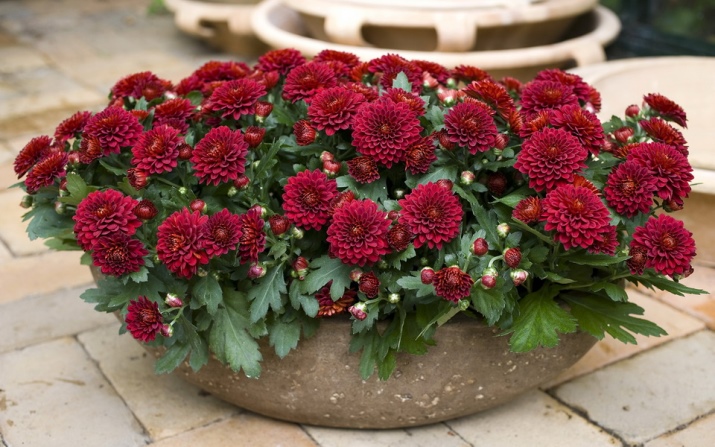

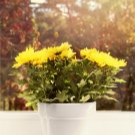
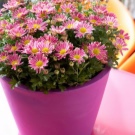

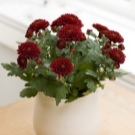
The size and shape of the leaves of potted chrysanthemums depend on the varietal characteristics of the plant. The most common varieties are those with simple, dissected and serrated leaves. The color of the leaves can be pale emerald or gray-green. Most varieties bloom at the end of August and lasts until December. During this period, the plants are covered with small but very beautiful flowers. The shape of flowers can be simple, anemone, terry, semi-double or pompom.
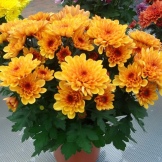
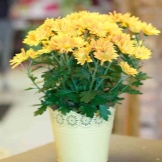
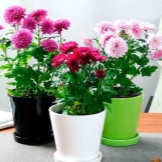
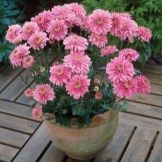
The color and size of flowers depends on the plant variety. The most popular among florists are chrysanthemum varieties with large and small flowers of milky white, cream, pink-red, golden yellow, raspberry, orange-brown and pale lilac color. The root system of plants is superficial, branched. As the chrysanthemum grows, its roots develop parallel to the surface of the earth.
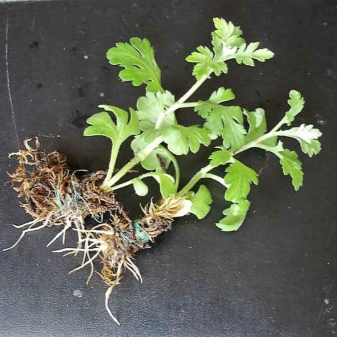
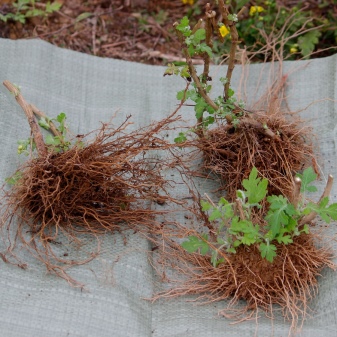
Household chrysanthemums, which have a bush and ampelous shape, are very popular with florists. The formation of the aboveground part of plants is usually carried out by cutting or pinching the stems.
Types and varieties
The most popular in indoor plant growing are Indian and Chinese chrysanthemums... These species are still used by breeders to obtain new original varieties with different typical characteristics. So, both of these species were used by scientists when breeding Korean chrysanthemums - a separate group of small-flowered varieties that are resistant to unfavorable environmental factors.
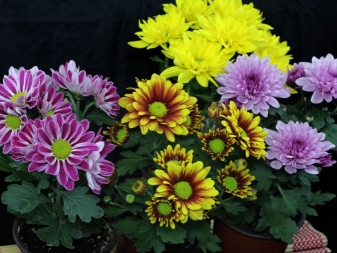
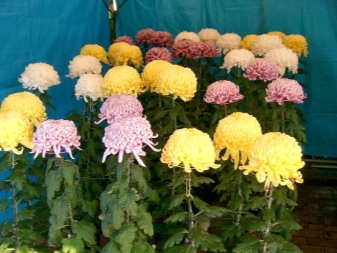
There are a number of significant differences between Indian, Chinese and Korean chrysanthemums. They consist both in the external characteristics of plants and in their requirements for growing conditions. Below are descriptions of the chrysanthemums of the indicated varieties, as well as the characteristics of the most interesting varieties.
Indian indoor chrysanthemums - a kind of large-flowered chrysanthemums, intended for cultivation exclusively at home. The average height of adult plants varies from 20 to 70 centimeters. The diameter of the aboveground part is usually about 15-17 centimeters.Chrysanthemums of this species are characterized by increased demands on the conditions of detention. They painfully tolerate temperature extremes, cold snaps, drafts, lack of moisture and sunlight.
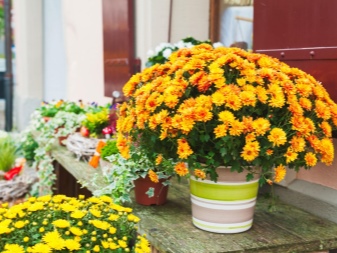
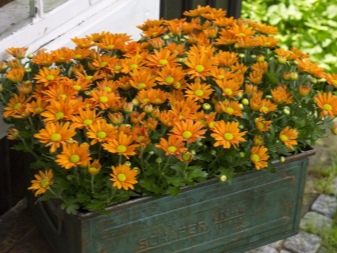
Chinese or garden chrysanthemums - a variety of very attractive highly decorative chrysanthemums, intended for growing both at home and in the open field. For growing at home, flower growers use low and medium-sized varieties, the height of which varies from 20 to 50 centimeters. The characteristic features of chrysanthemums of this species are unpretentiousness to care, long and colorful flowering.
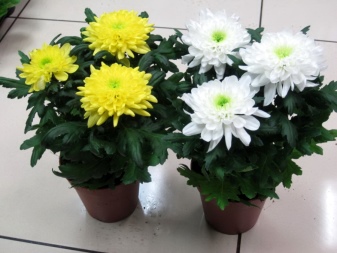
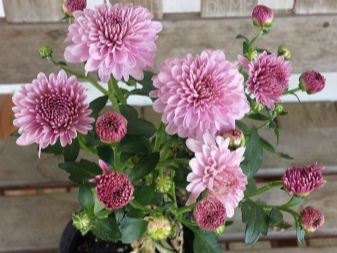
Korean chrysanthemums - a group of perennial small-flowered varieties suitable for growing at home and in the open field. In floriculture, these plants are widespread due to their unpretentiousness, endurance, resistance to drought and temperature extremes. To date, breeders have managed to develop varieties of Korean chrysanthemums with medium and large flowers.
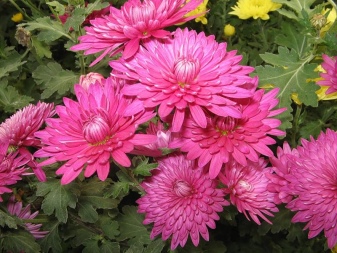
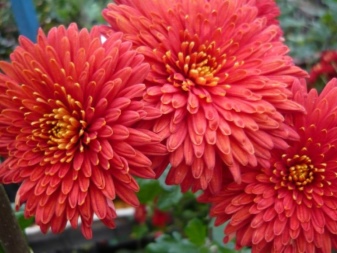
"Anastasia" - one of the most popular varieties of Indian indoor chrysanthemums, recommended for indoor cultivation. The average height of the bushes of adult plants can be 60-80 centimeters. The leaves are pinnately dissected, of a dark emerald hue. The flowers are large, lush, consisting of many long radial petals, united in dense baskets. The color of the flowers can be different - milky white, lemon yellow, creamy bronze, pinkish lilac.
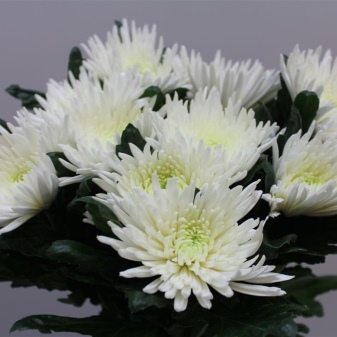
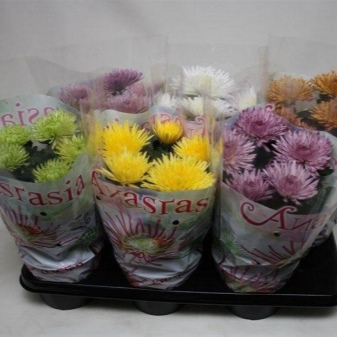
"Crystal" - a very attractive variety of chrysanthemums, intended for growing at home. The potted chrysanthemum of this variety is a low compact bush with thin straight stems directed upwards. The leaves are rich green, dense, pinnately dissected. The flowers are large, lush, semi-double or anemone. The color of the flowers is milky white, with a pale yellow or yellow-green core.
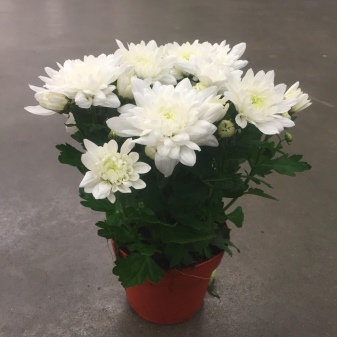

Zembla Mix - an original variety of Indian chrysanthemums with large (6-12 centimeters in diameter) flowers. Plant height can vary from 30 to 70 centimeters or more. Flowering begins in late summer or early autumn. Flowers are large, voluminous, often pompom or double-shaped. The color can be dazzling white, pale pink, pistachio green, purple red.
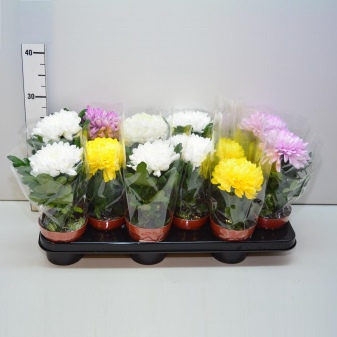
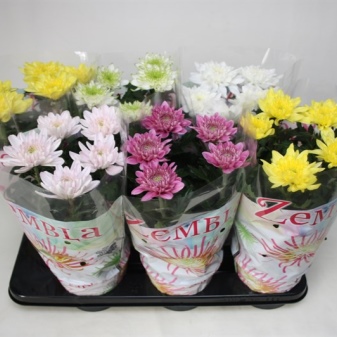
Baltika - a group of varieties of very spectacular bush chrysanthemums of foreign selection. When grown at home, the plants form compact bushes about 30-40 centimeters high. When grown outdoors, plants can be up to 60-70 centimeters tall. Flowering occurs in September-October. The size of lush double flowers usually does not exceed 12-13 centimeters. The color of flowers can be bright white (Baltika White), lemon yellow (Baltika Yellow), coral orange (Baltika Salmon), pale pink (Baltika Pink).
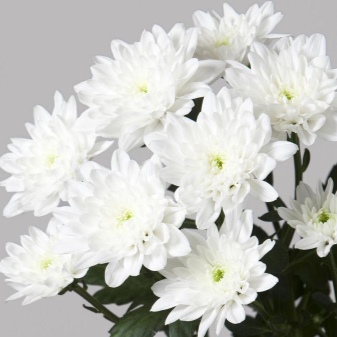

"Alexandrite" Is a spectacular variety of early flowering Korean chrysanthemums that can be grown both at home and outdoors. Adult plants are low (up to 40 centimeters in height), multi-stemmed bushes with graceful pinnately dissected leaves. The beginning of flowering is the second half or the end of August. Flowers are double or semi-double, reaching 5 centimeters in diameter. The color of the petals is lilac-pink on the periphery, lemon-yellow in the center.

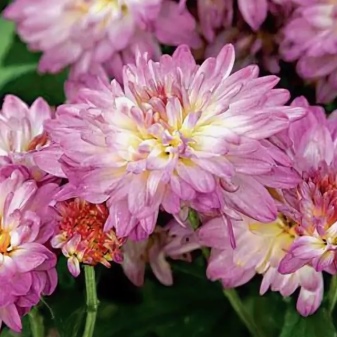
"Evening Lights" - a non-double, undersized variety, suitable for growing both indoors and outdoors. The average plant height is about 30 centimeters. Bushes are compact, hemispherical. Plants enter the flowering phase in the second half of August. The flowers are simple, chamomile-shaped, reaching about 5 centimeters in diameter. Coloring - crimson-red, with a golden-yellow core.
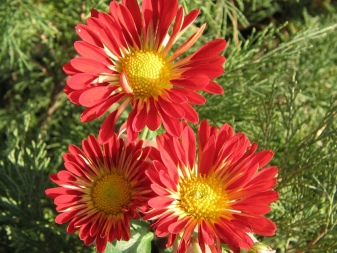

"Knopa" Is a very attractive, richly flowering variety.Plant height varies from 30 to 35 centimeters. Plants form compact, multi-stemmed bushes. Flowering begins in mid-autumn and continues until frost. During this period, chrysanthemums of this variety form numerous small flowers of a rich yellow color.
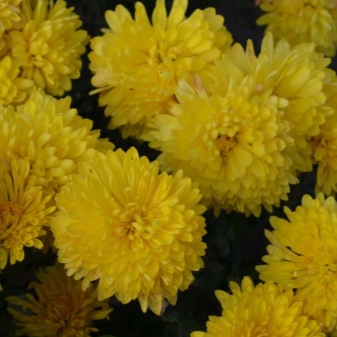
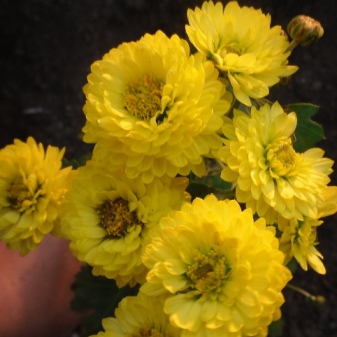
Conditions of detention
Domestic chrysanthemums are considered unpretentious plants that do not impose specific requirements on the conditions of their keeping. In order for these representatives of the ornamental flora to fully develop, bloom for a long time and abundantly, they need to ensure optimal light, humidity and temperature conditions. Besides, a significant role is played by the size of the pot (container) and the composition of the soil mixture used.


Pot selection
The root system of these plants is shallow, shallow in the ground. For this reason, when choosing a pot, preference should be given to wide and not too deep containers. Observations show that in tall and narrow pots, water stagnation occurs more often, leading to root rot. In addition, in such containers, the roots of chrysanthemums cannot receive the required amount of moisture.
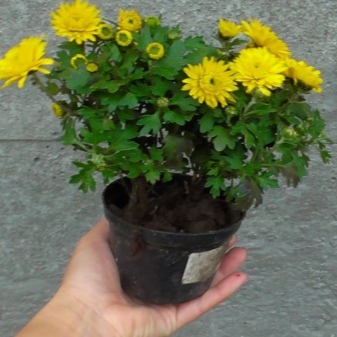
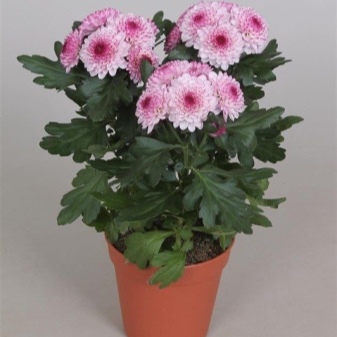
Lighting
For normal development, timely and long flowering, home chrysanthemums need full lighting. These plants prefer moderately bright, diffused sunlight. Direct sunlight is detrimental to these representatives of the ornamental flora. Experienced flower growers claim that the timing of the flowering of indoor chrysanthemums largely depends on the length of daylight hours. It has been noticed that many varieties of these plants are able to bloom continuously for 3-6 months if they receive enough light during the day (at least 12 hours a day). Short daylight hours negatively affect both duration and quality of flowering.

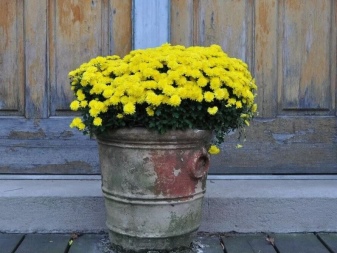
Temperature and humidity
When growing chrysanthemums at home, it is recommended to maintain a stable indoor temperature at + 18 ... + 22 °. When the temperature rises to + 25 ° (or more), these plants stop flowering, the development of buds stops, wilting and drying of the leaves begins. In very hot weather, flower growers recommend shading chrysanthemums and periodically spraying them with water from a spray bottle. It is important to note that plants in the flowering and budding phase cannot be sprayed with water.
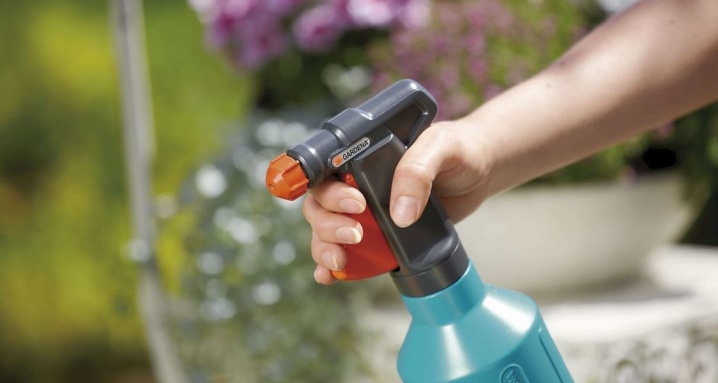
The humidity level in the room should be 50-70%. Dried air is equally harmful to the leaves and stems of chrysanthemums, as well as to their flowers and buds.
Priming
The soil mixture is considered optimal for growing potted chrysanthemums, consisting of the following components:
- garden fertile land (3 parts);
- peat soil (1 part);
- leaf humus (part 1);
- clean medium-grained sand (1 part).

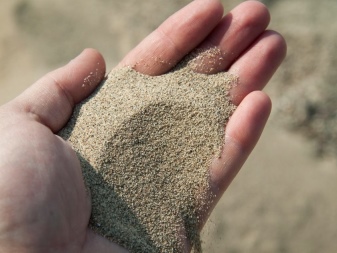
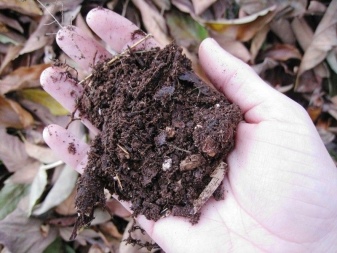
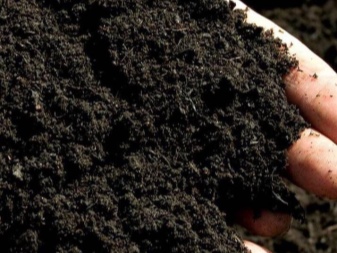
Suitable for growing these plants and ready-made store soil mixtures intended for ornamental crops. The acidity level of the soil should be around 6-6.5. The soil mixture itself must be loose, moisture and air permeable.
Transfer to another container
It is not recommended to replant plants immediately after purchase. The new green pet must be given some time to adapt to unfamiliar conditions. If the plant is blooming or has buds, you should wait until the end of flowering. The fact that the chrysanthemum has successfully adapted to an unfamiliar environment will be evidenced by the growth of its old and the development of new shoots. At this stage, the plant should be transplanted into a spacious, wide container. The transplant is carried out carefully, removing the flower from the old pot along with the earthen lump. The size of the new pot should be about 1-1.5 times the diameter of the root ball.
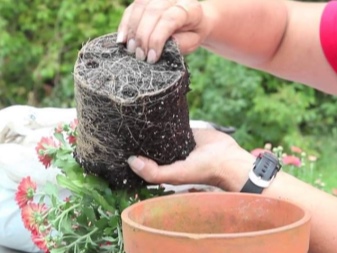
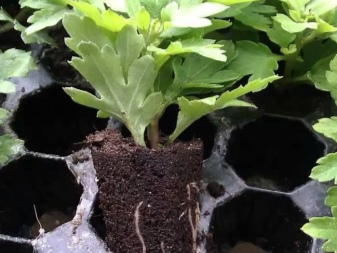
Before transplanting, a drainage layer should be laid on the bottom of the pot. In its capacity, you can use river pebbles, small pieces of foam, gravel.Shop chrysanthemums purchased in winter can be planted with the arrival of spring. A transplant carried out in winter can negatively affect the dormant stage in which the plant resides.
It is recommended to replant young potted chrysanthemums every year until the plants are 3-4 years old. The size of the new pots should be slightly larger than the size of the old containers. During the transplant, the old soil mixture is replaced. Damaged, deformed or dry fragments of roots and shoots are removed during the procedure with sharp scissors or pruning shears. After transplanting, the plants are placed in a shaded area, protected from drafts.
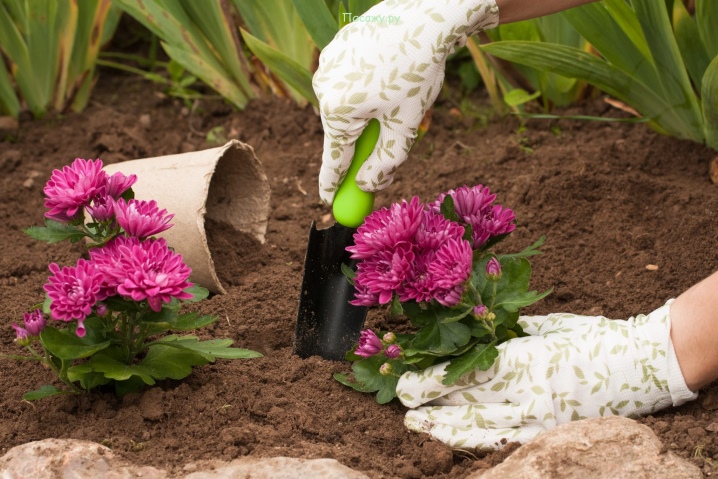
Correct care
In order for chrysanthemums growing at home to feel comfortable and bloom regularly, they need to be provided with competent care. Experienced flower growers say that caring for these plants is not difficult at all.
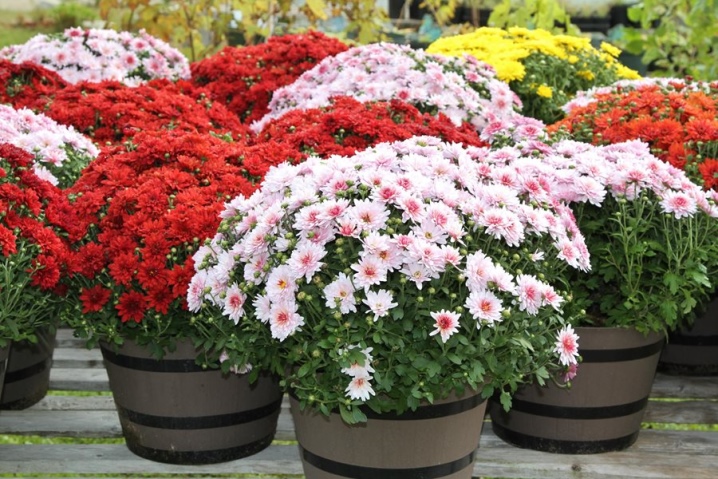
Watering
Potted chrysanthemums need frequent, but abundant watering. It is important not to allow the soil surface in the pot to dry out too much. However, these plants should not be over-watered either. If moisture stagnates in the soil, green pets can suffer from the development of fungal diseases. Watering is desirable in the evening or morning hours. The recommended frequency of watering is 2-3 procedures per week. In cloudy and cool weather, the frequency of watering is reduced.
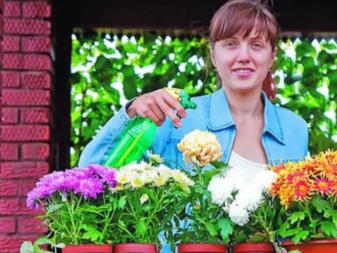
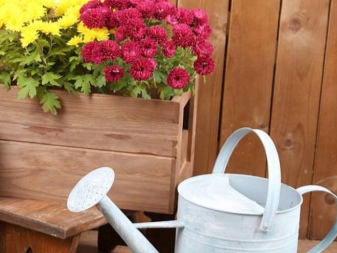
Top dressing
During the entire growing season, indoor chrysanthemums are recommended to be fed once every 7-10 days. Most flower growers use store-bought complex fertilizers (Fertika Lux, Bona-Forte) as top dressing. Some growers feed plants according to the following schedule:
- in the spring (in the phase of active development of chrysanthemums) - nitrogen-containing fertilizers;
- during the period of bud formation and flowering - potash-phosphorus fertilizers.
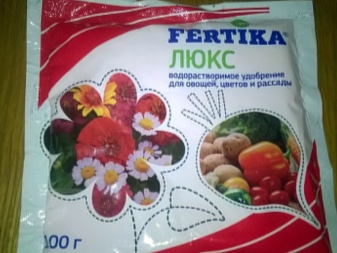
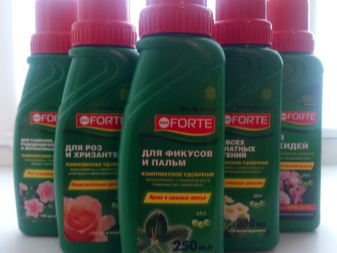
It is allowed to feed the plants 10-12 hours after watering. Nitrogen-containing fertilizers are applied only in spring to prevent intensive growth of green mass. Potassium-phosphorus fertilizing ceases to be applied after flowering ends.
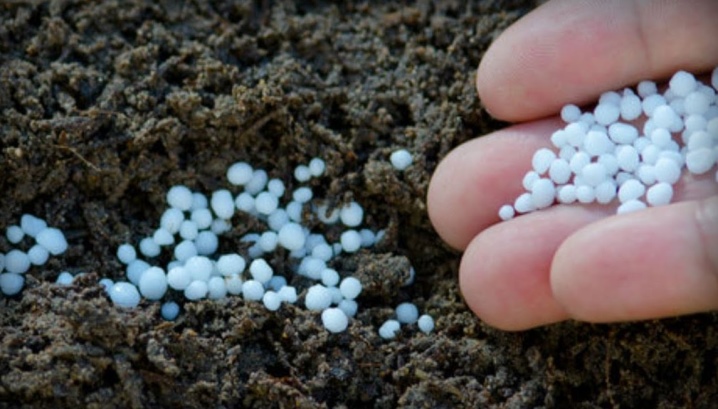
Pruning and pinching
Periodic pruning and pinching of shoots allows you to form neat and compact bushes. Also, these procedures help to preserve the strength of plants, which they require to form flower ovaries. Pinching involves removing the tops of growing shoots. This procedure activates the growth of lateral stems, helps to awaken the "dormant" lateral buds. Small-flowered varieties are pinched about 2 times per season, large-flowered varieties - about 3 times per season. Plants should be pinched before flowering. It is advisable to cut off all unnecessary, stretching, excessively long shoots that violate the symmetry and proportions of the bush. Pruning is carried out in the spring, when the plants enter a phase of active development.

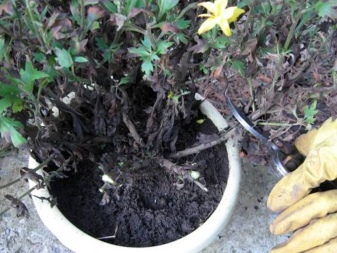
Be sure to carry out the procedure for pruning plants before wintering. In this case, the bushes are shortened with sharp scissors or pruning shears almost to the ground, leaving only small hemp above its surface.
Dormant period
After the potted chrysanthemum has faded, it needs to be provided with rest. This period is very important for the restoration of the resources spent by the plant on budding, flowering, and the formation of young shoots. Preparing chrysanthemums for the dormant period consists in pruning the bushes to a height of 10 centimeters from the surface of the earth. Next, the pot with the plant should be placed in a very cool but bright place. In this case, the air temperature in the room should not exceed + 5 ... + 8 °. This temperature range is considered the most suitable for wintering plants. During the entire dormant period, chrysanthemums should be watered no more than 1 time per month.

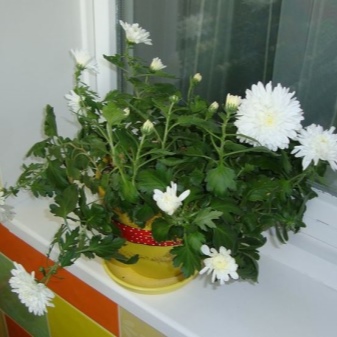
Why doesn't it bloom and what to do about it?
Most varietal chrysanthemums enter the flowering phase in the fall.If this does not happen, you can try to get the plant to bloom using various methods. The most popular reason for not blooming is nutrient deficiencies in the soil. For to eliminate the problem, it is necessary to feed the plants with phosphorus-potassium fertilizers.
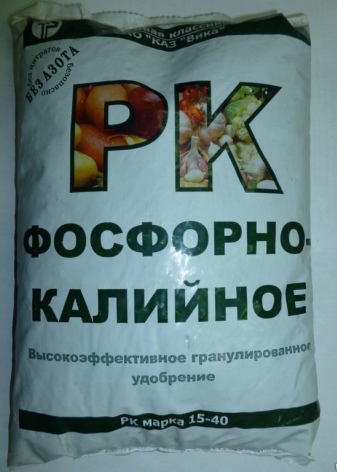
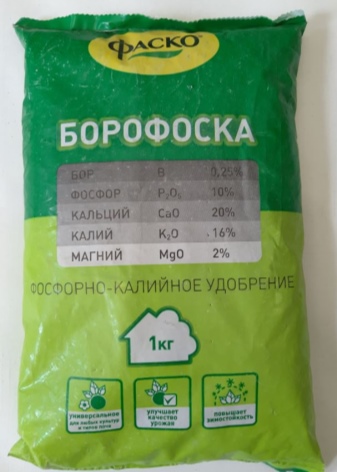
Another reason may lie in the lack of lighting. In this case, in order for the chrysanthemum to bloom, it needs to provide adequate lighting throughout the day. The lack of natural light can be compensated for with the help of artificial light sources - phyto-lamps or fluorescent lamps.
Landing in open ground
Many varieties of indoor chrysanthemums develop well and bloom outdoors. The most adapted to the external environment are Korean chrysanthemums, which are resistant to adverse factors - temperature extremes, cooling, drafts, drought. Young and mature chrysanthemum bushes of cold-resistant varieties can be planted outdoors (in open ground) only after the soil warms up and the threat of night frosts disappears. The recommended time for disembarkation is late May or early June.
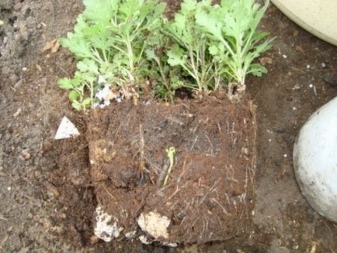

Bushes should be planted in well-lit areas of the garden with a small sparse shadow. The soil at the planting site should be loose, fertile, moderately moist. It is not allowed to plant domestic chrysanthemums in places with a high level of groundwater. Before planting, pits are prepared with a depth of about 30 centimeters. The size of the holes is calculated based on the size of the root ball of the seedlings. The distance between the pits should be about 50 centimeters.
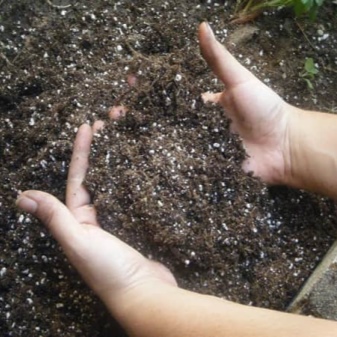
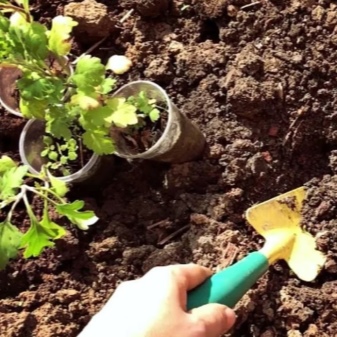
A sand and gravel mixture is laid at the bottom of the pits, on top of which a layer of garden soil is poured. Next, the seedling is placed vertically in a pit along with a lump of earth on the roots. Twisted and knocked out roots are carefully straightened and the hole is filled with nutritious soil. At the end of the work, the earth in the near-trunk circle is slightly compacted, the bush is watered and temporarily shaded from the sun.
Reproduction methods
Domestic chrysanthemums are usually propagated by cuttings or dividing the mother bush. Florists rarely resort to seed propagation. Cuttings are harvested in spring, when the plant is completely out of the dormant phase. When the shoots of the bush reach a height of 13-15 centimeters, they begin to harvest the planting material. To do this, the shoots of the mother bush are cut into cuttings 10-12 centimeters long, which are immediately placed in containers with loose and moist soil mixture, deepening the lower part by 1-1.5 centimeters. Next, the container with cuttings is covered with glass or foil. Throughout the rooting of cuttings inside the container, high humidity is maintained by spraying. Cuttings take root within a few weeks.
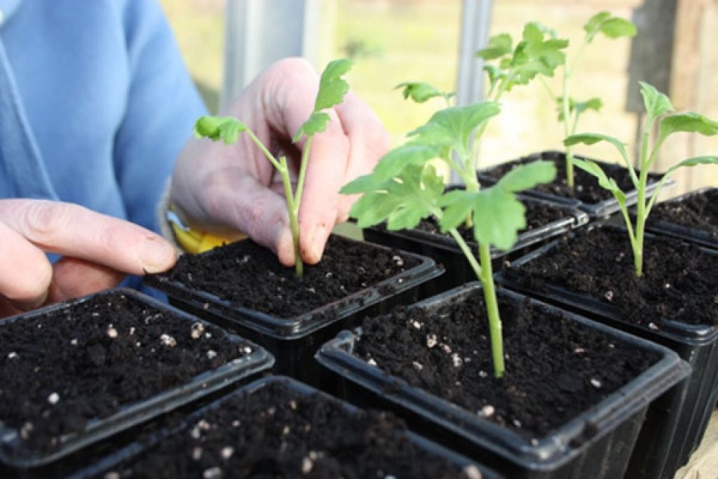
Separation of mother bushes is carried out in early spring. The bushes are separated by hand or with a secateurs. As a rule, one adult chrysanthemum bush is enough to get 2-3 full-fledged divisions. They are planted in containers and sent to a cool room, where high humidity is maintained until the plants fully adapt. To grow indoor chrysanthemums from seeds, you need to prepare high-quality planting material, containers with a drainage layer and a loose nutrient substrate. The recommended sowing time is late February or early March.
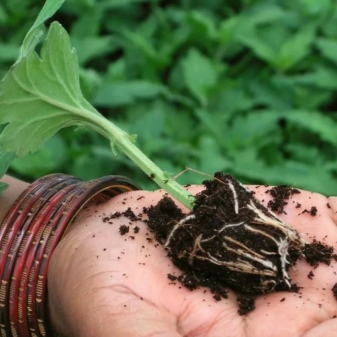

Seeds are sown in rows in containers with a substrate. Seeds of annual varieties are sprinkled on top with a thin layer of sand. Seeds of perennial varieties are lightly pressed into the substrate with fingertips. After sowing, the soil is well sprayed with a spray bottle and the container is covered with glass. The first shoots appear in about 3-4 weeks. When at least 4 true leaves are formed on the seedlings, young plants can be planted one at a time in separate cups.
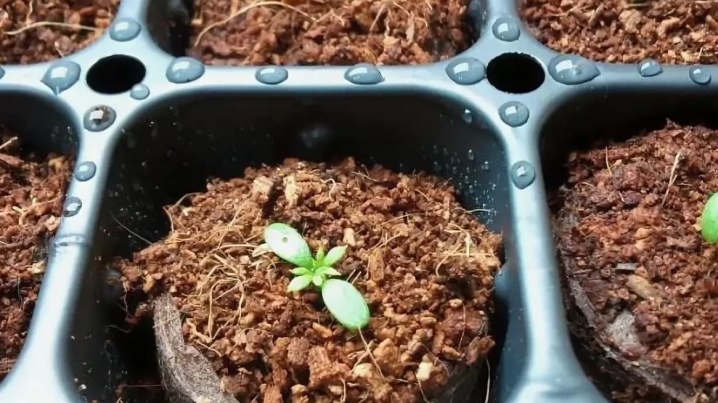
Diseases and pests
Indoor chrysanthemums often suffer from invasions of spider mites and aphids that feed on cell juices. A plant affected by these pests withers, dries up, sheds foliage. You can get rid of parasites with the help of insecticides (Fitoverm, Aktellik). If the rules of care are violated, domestic chrysanthemums are often affected by various types of rot. The development of these diseases is usually indicated by gray-brown, brown and brown-black spots on the leaves and inflorescences. Treatment is carried out with fungicidal and copper-containing preparations.
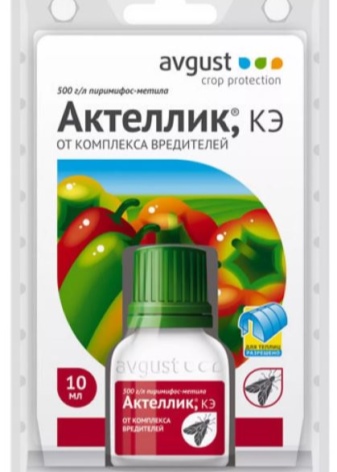
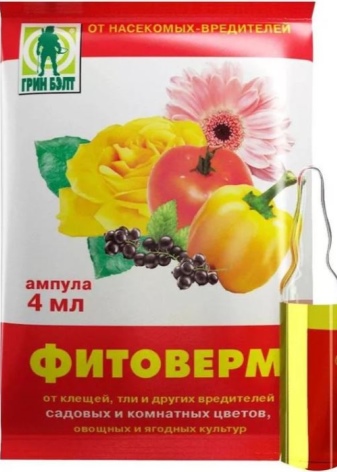
If chrysanthemums first turn yellow, and then turn black and shed their leaves, this may indicate the development of septoria. Treatment involves the use of drugs such as Fundazol, Hom, Bordeaux liquid.
Advice
In order for the indoor chrysanthemum to delight with lush flowering for a long time, you must adhere to simple recommendations. So, experienced plant breeders recommend timely removing dried old inflorescences and leaves from the bushes. Another secret of long flowering is the timely removal of excess buds and inflorescences. Observations show that their excessive amount negatively affects the quality and duration of chrysanthemum flowering.
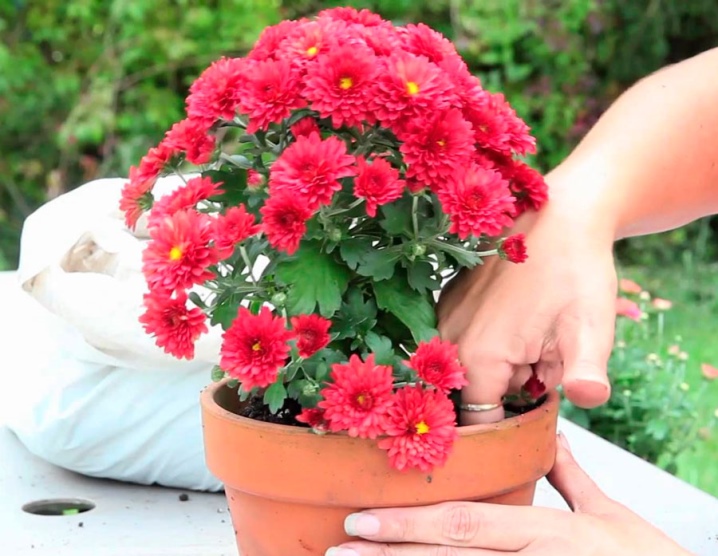
For information on how to properly care for a chrysanthemum in a pot, see the next video.







































































































The comment was sent successfully.